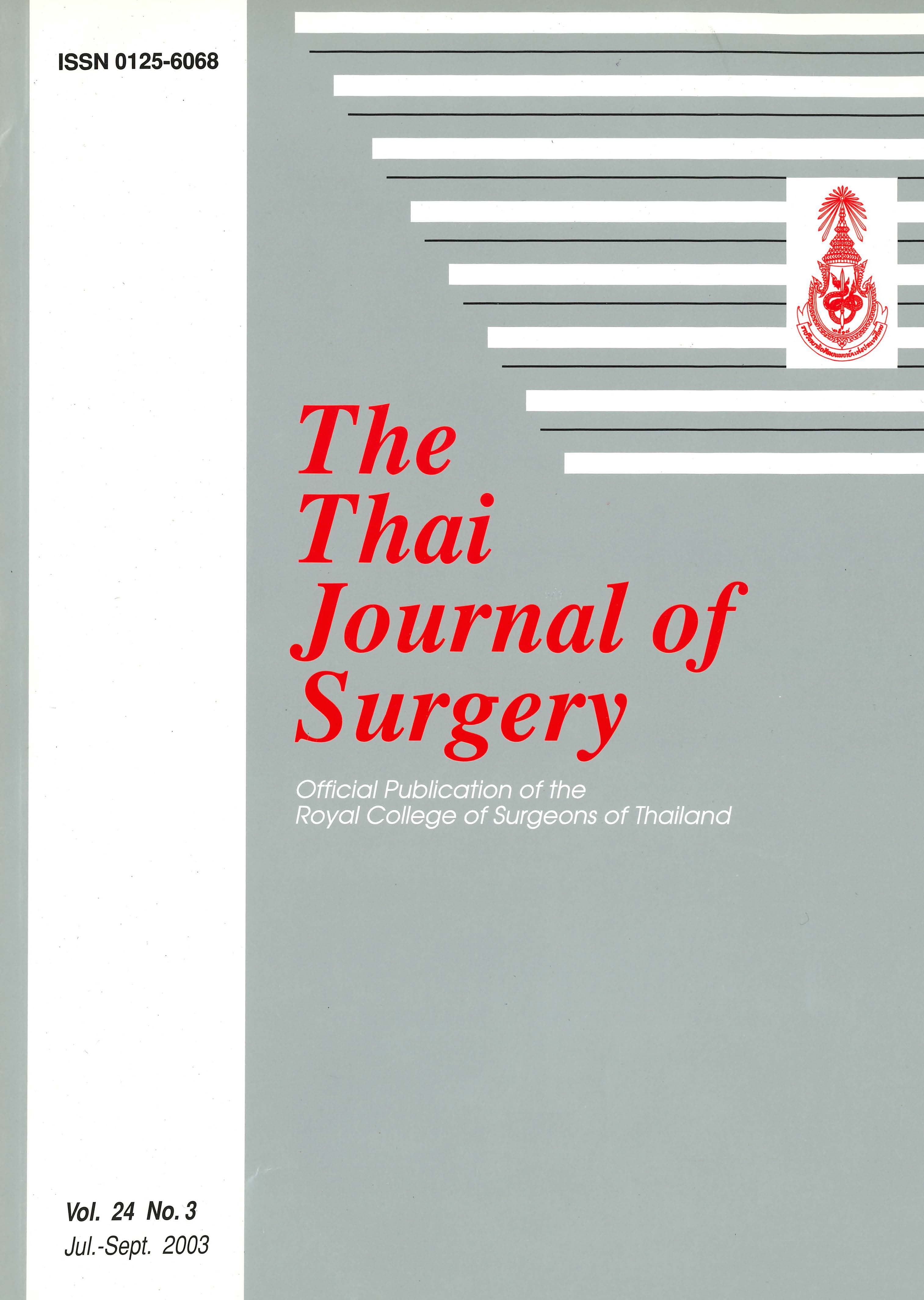An Impact of Helicobacter pylori Eradication after Simple Closure of Perforated Peptic Ulcer: A Prospective Randomized Trial
Abstract
Background: This study was carried out to evaluate the relationship of Helicobacter pylori (H. pylori) infection in perforated peptic ulcer patients and the benefit of H. pylori eradication on ulcer healing and ulcer recurrence after simple closure of perforated ulcer.
Materials and Methods: Sixty-six patients with perforated peptic ulcer were treated by simple closure with omental patch and intraoperative esophagogastroduodenoscopy (EGD) to assess H. pylori infection status. Patients were randomized into two groups; control group(group 1) received Omeprazole regardless of H. pylori status whereas the study group (group 2) H. pylori positive patients received a course of anti - H. pylori therapy. Follow-up EGD was performed at 2 months, and at I year after hospital discharge to evaluate ulcer healing and ulcer recurrence respectively.
Results: H. pylori infection rate was 86.3%, 50% and 92.8% in overall perforated ulcer, perforated gastric ulcer and perforated duodenal ulcer respectively. Ten patients did not return at 2 months for endoscopic follow-up. Of fifty-six patients, twenty-nine in group I and twenty-seven in group 2 underwent EGD at 2 months follow-up and revealed initial ulcer healing rate of 65.5% and 88.8% respectively (P =0 .038). At I year follow-up, ulcer recurrence rate of patients in group 1 was significantly higher than patients in group2 (36.8% and 5%, P = 0.02).
Conclusion: This study confirms a close relationship between H. pylori infection and perforated peptic ulcer. H. pylori eradication after simple closure and omental patch can promote initial ulcer healing and prevent ulcer recurrence as well. Immediate acid reduction surgery should be reserved only for patients who have obvious risk of gastric outlet obstruction.
References
2. Drury JK, McKay AJ, Hutchison JS. Natural history of perforated duodenal ulcers treated by suture closure. Lancet 1978;7:2(8093): 749-50.
3. Bornman PC, Theodorou NA, Jeffery PC, et al. Simple closure of perforated duodenal ulcer: a prospective evaluation of a conservative management policy. Br J Surg 1990;77:73-5.
4. Backgaard N, Lawaetz O, Poulsen PE. Simple closure or definitive surgery for perforated duodenal ulcer. Scand J Gastroenterol 1979;14:17-20.
5. Gray JG, Roberts AK. Definitive emergency treatment of perforated duodenal ulcer. Surg Gynecol Obstet 1976; 143:890-4.
6. Coutsoftides T, Himal HS. Perforated gastroduodenal ulcers. Factors effecting morbidity and mortality and the role of definitive surgery. Am J Surg 1976; 132: 575-6.
7. Sawyers JL, Lynwood HL, Mulherin JL, et al. Acute perforated duodenal ulcer. Arch Surg 1975; 110: 527-30.
8. Ceneviva R, de Castro e Silva OJ, Castelfranchi PL, et al. Simple suture with or without proximal gastric vagotomy for perforated duodenal ulcer. Br J Surg 1986: 73: 427-30.
9. Tanphiphat c, Tanprayoon T, Na Thalang A. Surgical treatment of perforated duodenal ulcer: a prospective trial between simple closure and definitive surgery. Br J Surg 1985; 72: 370-2.
10. Marshall BJ, Warren JR. Unidentified curved bacilli in the stomach of patients with gastritis and peptic ulceration. Lancet 1984; i: 1311-5.
11. Tytgat GNJ, Rauws EAJ. Compylobacter pylori and its role in peptic ulcer disease. Gastroenterol Clin North Am 1990; 19:183-96.
12. Marshall BJ, Goodwin CS, Warren JR, et al. Prospective double-blind trial of duodenal ulcer relapse after eradication of Compylobacter pylori. Lancet 1988; ii: 1437-42.
13. Sawyers JL, Lynwood HL. Perforated duodenal ulcer managed by proximal gastric vagotomy and suture plication. Ann Surg 1977; 185: 656-60.
14. Jordan PHJ. Proximal gastric vagotomy without drainage for treatment of perforated duodenal ulcer. Gastro-enterology 1982; 83: 179-83.
15. Christiansen J, Andersen OB, Bonnesen T, et al. Perforated duodenal ulcer managed by simple closure versus closure and proximal gastric vagotomy. Br J Surg 1987; 74: 286-7.
16. Simpson CJ, Lamont G, Macdonald I, et al. Effect of cimethidine on prognosis after simple closure of perforated duodenal ulcer. Br J Surg 1987; 74: 104-5.
17. Raimes SA, Devlin HB. Perforated duodenal ulcer. Br J Surg 1987;74:81-2.
18. Graham DY, Go MF. Helicobacter pylori: Current status. Gastroenterology 1993; 105: 279-82.
19. Rauws EAJ, Tytgat GNL. Cure of duodenal ulcer associated with eradication of Helicobacter pylori. Lancet 1990; 335:1233-5.
20. Forbes GM, Glaser ME, Cullen DJ, et al. Duodenal ulcer treated with Helicobacter pylori eradication: seven year follow-up. Lancet 1994; 343: 258-60.
21. National Institute of Health. Helicobacter pylori in peptic ulcer disease. NIH Consensus Statement 1994; 12: 1-23.
22. Laine L. The long-term management of patients with bleeding ulcers: Helicobacter pylori eradication instead of maintenance antisecretory therapy. Gastrointest Endosc 1995;41:77-9.
23. Reinbach DH, Cruickshank G, McColl KE. Acute perforated duodenal ulcer is not associated with Helicobacter pylori infection. Gut 1993; 34:1344-7.
24. Chowdhary SK, Bhasin DK, Panigrahi D, et al. Helicobacter pylori infection in patients with perforated duodenal ulcer. Trop Gastroenterol 1998; 19: 19-21.
25. Sebastian M, Chandran VP, Elashaal YL, et al. Helicobacter pylori infection in perforated peptic ulcer disease. Br J Surg 1995;82: 360-2.
26. Ng EKW, Chung SCS, Sung JJY, et al. High prevalence of Helicobacter pylori infection in duodenal ulcer perforation not caused by non-steroidal anti-inflammatory drugs. Br J Surg 1996; 83: 1779-81.
27. Chu KM, Kwok KF, Law SYK, et al. Helicobacter pylori status and endoscopy follow-up of patients having a history of perforated duodenal ulcer. Gastrointest Endosc 1999; 50: 58-62.
28. Tokunaga Y, Hata K, Ryo J, et al. Density of Helicobacter pylori infection in patients with peptic ulcer perforation. J Am Coll Surg 1998; 186: 659-63.
Downloads
Published
How to Cite
Issue
Section
License
Articles must be contributed solely to The Thai Journal of Surgery and when published become the property of the Royal College of Surgeons of Thailand. The Royal College of Surgeons of Thailand reserves copyright on all published materials and such materials may not be reproduced in any form without the written permission.



